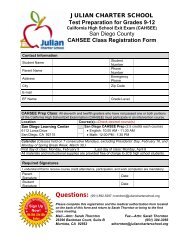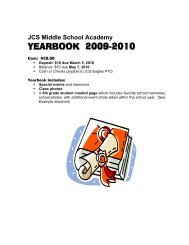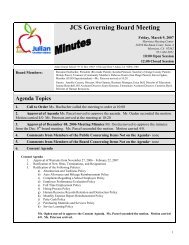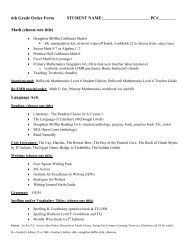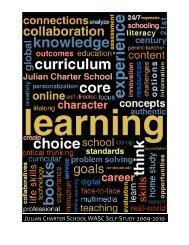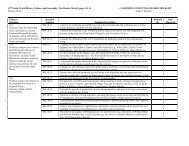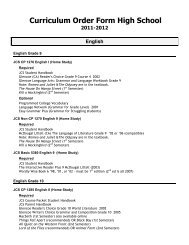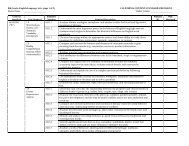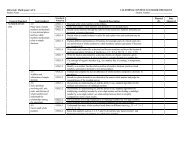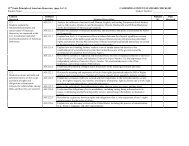Kindergarten: Math CALIFORNIA CONTENT-STANDARD ...
Kindergarten: Math CALIFORNIA CONTENT-STANDARD ...
Kindergarten: Math CALIFORNIA CONTENT-STANDARD ...
You also want an ePaper? Increase the reach of your titles
YUMPU automatically turns print PDFs into web optimized ePapers that Google loves.
<strong>Kindergarten</strong>: <strong>Math</strong><br />
Student Name: ___________________________<br />
<strong>CALIFORNIA</strong> <strong>CONTENT</strong>-<strong>STANDARD</strong> CHECKLIST<br />
Student Number: ___________________<br />
General Standard<br />
NUMBER SENSE<br />
(NS)<br />
ALGEBRA AND<br />
FUNCTIONS (AF)<br />
MEASURE-MENT<br />
AND GEOMETRY<br />
(MG)<br />
STATISTICS,<br />
DATA ANALYSIS,<br />
AND<br />
PROBABILITY<br />
(SDP)<br />
MATHEMATICAL<br />
REASONING (MR)<br />
Sub-Standard<br />
Standard<br />
Notation<br />
Standard Description<br />
1.0 Relationships K.NS.1.1 Compare two or more sets of objects (up to ten objects in each group) and identify<br />
between numbers and<br />
which set is equal to, more than, or less than the other<br />
quantities<br />
K.NS.1.2 Count, recognize, represent, name, and order a number of objects (up to 30)<br />
K.NS.1.3 Know that larger numbers describe sets with more objects in them than the<br />
smaller numbers have<br />
2.0 Simple addition K.NS.2.1 Use concrete objects to determine the answers to addition and subtraction<br />
and subtraction<br />
problems (for two numbers that are each less than 10)<br />
3.0 Estimation K.NS.3.1 Recognize when an estimate is reasonable when computing and solving problems<br />
with numbers in the ones and tens places)<br />
1.0 Sort and classify K.AF.1.1 Identify, sort, and classify objects by attribute and identify objects that do not<br />
objects<br />
belong to a particular group (e.g., all these balls are green, those are red)<br />
K.MG..1.1 Compare the length, weight, and capacity of objects by making direct<br />
comparisons with reference objects (e.g., note which object is shorter, longer,<br />
lighter, holds more).<br />
1.0 Concept of time<br />
and units to measure<br />
it; objects have<br />
properties (e.g.,<br />
length, weight, etc)<br />
2.0 Identify common<br />
objects in their<br />
environment and<br />
describe their<br />
geometric features<br />
1.0 Collect<br />
information about<br />
objects and events in<br />
their environment<br />
1.0 Make decisions<br />
about how to set up a<br />
problem<br />
2.0<br />
Solve problems in<br />
reasonable ways and<br />
justify their reasoning<br />
K.MG.1.2<br />
Demonstrate an understanding of concepts of time (e.g., morning, evening, today,<br />
yesterday, tomorrow, week, year) and tools that measure time (e.g., clock,<br />
calendar)<br />
K.MG.1.3 Name the days of the week<br />
K.MG.1.4 Identify the time (to the nearest hour) of everyday events (e.g., lunch time is 12<br />
o’clock; bedtime is 8 o’clock at night)<br />
K.MG.2.1 Identify and describe common geometric objects (e.g., circle, triangle, square,<br />
rectangle, cube, sphere, cone)<br />
K.MG.2.2 Compare familiar plane and solid objects by common attributes (e.g., position,<br />
shape, size, roundness, number of corners)<br />
K.SDP.1.1<br />
K.SDP.1.2<br />
K.MR.1.1<br />
K.MR.1.2<br />
K.MR.2.1<br />
K.MR.2.1<br />
Pose information questions; collect data; and record the results using objects,<br />
pictures, and picture graphs<br />
Identify, describe, and extend simple patterns (such as circles or triangles) by<br />
referring to their shapes, sizes, or colors<br />
Determine the approach, materials, and strategies to be used.<br />
Use tools and strategies, such as manipulatives or sketches, to model problems<br />
Explain the reasoning used with concrete objects and/or pictorial representations<br />
Make precise calculations and check the validity of the results in the context of the<br />
problem<br />
Planned<br />
(X)<br />
Date<br />
Mastered
<strong>Kindergarten</strong>: English-Language Arts<br />
<strong>CALIFORNIA</strong> <strong>CONTENT</strong>-<strong>STANDARD</strong> CHECKLIST<br />
Student Name: ____________________ Student Number: ______________________<br />
General<br />
Standard Sub-Standard<br />
Standard<br />
Notation<br />
Standard Description<br />
READING (“R”) 1.0 Reading K.R.1.1 Identify the front cover, back cover, and title page of a book<br />
K.R.1.2 Follow words from left to right and from top to bottom of a printed page<br />
K.R.1.3 Understand that printed materials provide information<br />
K.R.1.4 Recognize that sentences in print are made up of separate words.<br />
K.R.1.5 Distinguish letters from words<br />
K.R.1.6 Recognize and name all uppercase and lowercase letters of the alphabet<br />
K.R.1.7 Track and represent the number, sameness/difference, and order of two and three isolated<br />
phonemes (e.g., /f, s, th/, /j, d, j/)<br />
K.R.1.8 Track and represent changes in simple syllables and words with two and three sounds as one<br />
sound is added, substituted, omitted, shifted, or repeated<br />
K.R.1.9 Blend vowel-consonant sounds orally to make words or syllables<br />
K.R.1.10 Identify and produce rhyming words in response to an oral prompt<br />
K.R.1.11 Distinguish orally stated one-syllable words and separate into beginning or ending sounds<br />
K.R.1.12 Track auditorily each word in a sentence and each syllable in a word<br />
K.R.1.13 Count the number of sounds in syllables and syllables in words<br />
K.R.1.14 Match all consonant and short-vowel sounds to appropriate letters<br />
K.R.1.15 Read simple one-syllable and high-frequency words (sight words)<br />
K.R.1.16 Understand that as letters of words change, so do the sounds (alphabetic principle)<br />
K.R.1.17 Identify and sort common words in basic categories (e.g. colors, shapes, etc)<br />
K.R.1.18 Describe common objects and events in both general and specific language<br />
2.0 Reading K.R.2.1 Locate the title, table of contents, name of author, and name of illustrator<br />
Comprehension K.R.2.2 Use pictures and context to make predictions about story content<br />
K.R.2.3 Connect to life experiences the information and events in texts<br />
K.R.2.4 Retell familiar stories<br />
K.R.2.5 Ask and answer questions about essential elements of a text<br />
3.0 Literary K.R.3.1 Distinguish fantasy from realistic text<br />
Response and K.R.3.2 Identify types of everyday print materials<br />
Analysis K.R.3.3 Identify characters, settings and events<br />
WRITING (W) 1.0 Writing K.W.1.1 Use letters &phonetically spelled words to write about stories, people, objects, or events<br />
Strategies K.W.1.2 Write consonant-vowel-consonant words<br />
K.W.1.3 Write by moving from left to right and from top to bottom<br />
K.W.1.4 Write uppercase and lowercase letters of the alphabet independently, attending to form and<br />
proper spacing of the letters<br />
W/O<br />
1.0 W/O<br />
K.L.11 Recognize and use complete, coherent sentences when speaking<br />
LANGUAGE Language K.L.1.2 Spell independently using pre-phonetic knowledge, alphabet sounds & knowledge of letter<br />
(L)*<br />
names<br />
LISTENING & 1.0 Listening & K.LS.1.1 Understand and follow one- and two-step oral directions<br />
SPEAKING (LS) Speaking K.LS.1.2 Share information and ideas, speaking audibly in complete, coherent sentences<br />
* Written and Oral Language Conventions<br />
Planned<br />
(X)<br />
Date<br />
Mastered
<strong>Kindergarten</strong>: Science<br />
<strong>CALIFORNIA</strong> <strong>CONTENT</strong>-<strong>STANDARD</strong> CHECKLIST<br />
Student Name: ____________________ Student Number: ______________________<br />
General Standard<br />
Standard<br />
Notation<br />
Standard Description<br />
PHYSICAL SCIENCE<br />
K.1.a Objects can be described in terms of the materials they are made of (clay, cloth, paper,<br />
Properties of matter can be observed,<br />
etc.) and their physical properties (color, size, shape, weight, texture, flexibility,<br />
measured, and predicted<br />
attraction to magnets, floating and sinking, etc).<br />
K.1.b Water can be a liquid or a solid and can be made to change back and forth from one<br />
form to the other<br />
K.1.c Water left in an open container evaporates (goes into the air), but water in a closed<br />
container does not.<br />
LIFE SCIENCE<br />
K.2.a Observe and describe similarities and differences in the appearance and behavior of<br />
Different types of plants and animals<br />
plants and of animals (e.g., seed-bearing plants, birds, fish, insects).<br />
inhabit the Earth<br />
K.2.b Stories sometimes give plants and animals attributes they do not really have<br />
K.2.c Identify major structures of common plants and animals (e.g., stems, leaves, roots,<br />
arms, wings, legs)<br />
EARTH SCIENCE<br />
K.3.a Characteristics of mountains, rivers, oceans, valleys, deserts, and local land forms<br />
The Earth is composed of land, air, and K.3.b Changes in weather occur from day to day and across seasons, affecting the Earth and<br />
water<br />
its inhabitants<br />
K.3.c Identify resources from the Earth that are used in everyday life and know that many of<br />
them can be conserved<br />
INVESTIGATION AND<br />
K.4.a Observe common objects using the five senses<br />
EXPERIMENTATION<br />
K.4.b Describe the properties of common objects<br />
Scientific progress is made by asking<br />
K.4.c Describe the relative positions using one reference (e.g., above or below)<br />
meaningful questions and conducting<br />
K.4.d Compare and sort common objects based on one physical attribute (including color,<br />
careful investigations. (relates to three<br />
shape, texture, size, weight)<br />
other standards) K.4.e Communicate observations orally and in drawings.<br />
Planned<br />
(X)<br />
Date<br />
Mastered
<strong>Kindergarten</strong>: History-Social Science: Learning and Working Now and Long Ago<br />
<strong>CALIFORNIA</strong> <strong>CONTENT</strong>-<strong>STANDARD</strong> CHECKLIST<br />
Student Name: ____________________ Student Number: _______________________<br />
General Standard<br />
Standard<br />
Notation<br />
Standard Description<br />
K.1<br />
K.1.1<br />
Examples of rules, such as sharing and taking turns, and the consequences of breaking them<br />
Being a good citizen K.1.2<br />
Examples of honesty, courage, determination, individual responsibility, and patriotism in American and<br />
involves acting in<br />
world history, in stories and in folklore<br />
certain ways K.1.3 Know the beliefs and related behavior of characters in stories from times past, and understand the<br />
consequences of the characters actions<br />
K.2<br />
K.2.1<br />
Recognize national and state symbols and icons such as the national and state flags, the bald eagle, and<br />
Symbols<br />
the Statue of Liberty<br />
Planned<br />
(X)<br />
Date<br />
Mastered<br />
K.3<br />
Work that people do<br />
K.4<br />
Compare and contrast<br />
the locations of<br />
people, places, and<br />
environments<br />
K.5<br />
Put events in order<br />
K.6<br />
History relates to<br />
events, people, and<br />
places of other times<br />
K.3.1<br />
K.4.1<br />
K.4.2<br />
K.4.3<br />
K.4.4<br />
K.4.5<br />
K.5.1<br />
K.6.1<br />
K.6.2<br />
K.6.3<br />
Match simple descriptions of work that people do and the names of those jobs with examples from the<br />
school, local community and historical accounts<br />
Determine the relative location of objects using near/far, left/right, behind/in front<br />
Distinguish between land and water and locating general areas referenced in historically-based legends<br />
and stories on maps and globes<br />
Identify traffic symbols and map symbols (legend references to land, water, roads, and cities)<br />
Construct maps and models of neighborhoods, incorporating such structures as police and fire stations,<br />
airports, banks, hospitals, supermarkets, harbors, schools, homes, places of worship, and transportation<br />
lines<br />
Demonstrate familiarity with the school’s layout, environs and the jobs people do there<br />
Put events in temporal order by using a calendar, placing days, weeks, and months in proper order<br />
Identify the purposes of, and the people and events honored in, commemorative holidays, including the<br />
human struggles that were behind the events (e.g., Thanksgiving, Independence Day, Washington’s and<br />
Lincoln’s Birthdays, Martin Luther King Jr. Day, Memorial Day, Labor Day, Columbus Day, and<br />
Veteran’s Day)<br />
Know the triumphs in American legends and historical accounts through the stories of such people as<br />
Pocahontas, George Washington, Booker T. Washington, Daniel Boone, and Benjamin Franklin<br />
Understand the different ways people lived in earlier days and how their lives would be different today<br />
(e.g., the process of getting water from a well, growing food, making clothing, having fun, the type of<br />
organizations, rules, and laws)



